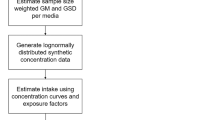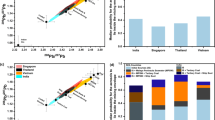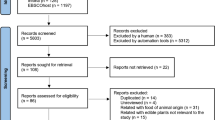Abstract
The Colorado River shows low levels of perchlorate derived from aerospace- and defense-related fuel industries once located near the Las Vegas Wash. At sufficiently high dosages perchlorate can disrupt thyroid function by inhibiting uptake of iodide. The Colorado River is the primary source of irrigation water for most food crops grown in Southern California and Southwestern Arizona. The objective of this study was to evaluate potential perchlorate exposure from food crops produced in the lower Colorado River region (LCRR). The major food commodities produced in the region were sampled and perchlorate levels were determined by ion chromatography followed by detection using either conductivity or tandem mass spectrometry, depending on analyte levels. The Monte Carlo module of the Dietary Exposure Evaluation Model (DEEM™) was used to derive an estimate of the 2-day average perchlorate intakes. Data were derived assuming that individuals residing in the LCRR get their fruits and vegetables from within the LCRR as well as from other areas in the United States, or assuming individuals living in the LCRR get their fruits and vegetables from the LCRR only. Perchlorate exposure estimates derived in this study are comparable to exploratory estimates by the US Food and Drug Administration. For infants and children, over 50% of the estimated perchlorate exposure was from milk. The relative impact of vegetables and fruit toward perchlorate exposure increased by age through adulthood. Cumulative perchlorate exposure estimates based on this hypothetical analysis could approach or exceed the NAS reference dose (RfD) for some population groups as drinking water levels exceeded 6 μg/l. However, few individuals are exposed to perchlorate in drinking water at levels above 4 μg/l in the United States and very few would be exposed to perchlorate levels exceeding the RfD, whether consuming food crops from within or outside the LCRR.
This is a preview of subscription content, access via your institution
Access options
Subscribe to this journal
Receive 6 print issues and online access
$259.00 per year
only $43.17 per issue
Buy this article
- Purchase on Springer Link
- Instant access to full article PDF
Prices may be subject to local taxes which are calculated during checkout



Similar content being viewed by others
References
Barraj L., Blount B., Sanchez C., Scrafford C., and Krieger R. Avoiding Perchlorate Exposures from Fresh Fruits and Vegetables: At What Costs? Presented at the 2007 Annual Society of Toxicology meeting, Charlotte, NC, 2007.
Blount B.C., Pirkle J.L., Osterloh J.D., Valentin-Blasini L., and Caldwell K.L. Urinary perchlorate and thyroid hormone levels in adolescent and adult men and women living in the United States. Environ Health Persp 2006a: 114: 1865–1871.
Blount B.C., Valentin-Blasini L., Osterloh J.D., Mauldin J.P., and Pirkle J.L. Perchlorate exposure of the US population, 2001–2002. J Exposure Sci and Environ Epid 2007: 17: 400–407.
Blount B.C., Valentini-Blasini L., and Ashley D.L. Assessing human exposure to perchlorate using biomonitoring. J ASTM Int 2006b: 3 (7): 1–6; doi:10.1520/JAI100398.
Clark J.J. Perchlorate toxicology (Chapter 3). In: Urbansky ET (ed.) Perchlorate in the Environment. Kluwer/Plenum, New York, NY, 2000, pp 15 –30.
Dasgupta P.K., Martinelango P.K., Jackson W.A., Anderson T.A., Tian K., and Tock R.W. The origin of naturally occurring perchlorate: the role of atmospheric processes. Environ Sci Tech 2005: 39: 1569–1575.
Dyke J.V., Kazuaki I., Obitsu T., Yoshiharu H., Dagupta P.K., and Blount B.C. Perchlorate in dairy milk. Comparisons of Japan versus the United States. Environ Sci Techol 2007: 41: 88–92.
El Aribi H.Y., Le Blanc J.C., Antonsen S., and Sakuma T. Analysis of perchlorate in food and beverages by ion chromatography coupled with tandem mass spectroscopy (IC-ESI-MS/MS). Analytica Chimica Acta 2006: 567: 39–47.
Ellington J.J., and Evans J.J. Determination of perchlorate at parts-per-billion levels in plants by ion chromatography. J Chromatr 2000: 898: 193–199.
FDA. Exploratory data on perchlorate in food. Food and Drug Administration: Washington, DC, 2004: www.cfsan.fda.gov/~dms/clo4data.html.
FDA. Office of food additive safety, center for food safety and applied nutrition. Guidance for industry. Estimating Dietary Intake of Substances in Food 2006. Available at: http://www.cfsan.fda.gov/~dms/opa2cg8.html.
FDA. Preliminary Estimation of Perchlorate Dietary Exposure Based on FDA 2004/2005 Exploratory Data 2007: http://www.cfsan.fda.gov/~dms/clo4ee.html.
Greer M.A., Goodman G., Pleus R.C., and Greer S.E. Health effects for environmental perchlorate contamination: the dose response for inhibition of radioiodide uptake in humans. Environ Health Perspect 2002: 110: 927–937.
Imperial County. Agricultural Crop and Livestock Report 2005: http://www.imperialcounty.net/ag/clereports.htm.
Jackson W.A., Joseph P., Laxman P., Tan K., Smith P.N., Yu L., and Anderson T.A. Perchlorate accumulation in forage and edible vegetation. J Agric Food Chem 2005: 53: 369–373.
Kirk A.B., Dyke J.V., Martin C.F., and Dasgupta P.K. Temporal patterns of perchlorate, thiocyanate, and iodide excretion in human milk. Environ Health Perspect 2007: 115: 182–186.
Kirk A.B., Martinelngo P.K., Tian K., Dutta A., Smith E.E., and Dasgupta P.K. Perchlorate and iodine in dairy and breast milk. Environ Sci Techol 2005: 39: 2011–2017.
Mendiaratta S.K., Dotson R.L., and Brooker R.T. Perchloric acid and perchlorates. In: Kirk Othmer (ed.) Encyclopedia of Chemical Technology. John Wiley and Sons Inc, New York, NY, 1996, pp 157–170.
Murray C.W., Egan S.K., Kim H., Nega B., and Bolher P.M. US Food and Drug Administration's total diet study: dietary intake of perchlorate and iodide. J Exposure Sci and Environ Epid 2008: 17: 1–10.
National Academy of Science. Health Implications of Perchlorate Ingestion. National Research Council of the National Academies Press, Washington, DC, 2005.
National Agricultural Statistics Service. 2005: http://www.nass.usda.gov/Primarily data on 2005 cropping season.
National Centers for Health Statistics (NCHS). The National Health and Nutrition Examination Survey (NHANES) 1999–2000 2004a Public Data Release (http://www.cdc.gov/nchs/about/major/nhanes/NHANES99_00.htm).
National Centers for Health Statistics (NCHS). The National Health and Nutrition Examination Survey (NHANES) 2001–2002 2004b, Public Data Release (http://www.cdc.gov/nchs/about/major/nhanes/nhanes01-02.htm).
National Centers for Health Statistics (NCHS). The National Health and Nutrition Examination Survey (NHANES) 2003–2004 2006. Public Data Release (http://www.cdc.gov/nchs/about/major/nhanes/nhanes2003-2004/nhanes03_04.htm).
National Research Council (NRC). Committee on pesticides in the Diets of Infants and Children. Pesticides in the Diets of Infants and Children. National Academy Press, Washington, DC, 1993.
Nevada Department of Environmental Quality. Lake Mead Water Quality Forum 2006, summary. 2006 http://ndep.nv.gov/forum/minutes_021506.pdf.
Pearce E.N., Pino S., He X., Bazrafshan H.R., Lee S.L., and Braverman L.E. Sources of dietary iodine: bread, cows’ milk, and infant formula in the Boston area. J Clin Endrocrinol 2005: 89: 3421–3424.
Pearce E.N., Leung A.M., Blount B.C., Bazrafshan H.R., He X., Pino S., Valentin-Blasini L., and Braverman L.E. Breast milk iodine and perchlorate concentrations in lactating boston-area women. J Clin Endrocrinol Metab 2007: 92: 1673–1677. doi:10/1210/jc.2006-2738
Riverside County -Palo Verde Valley. Acreage and Agricultural Crop Report. Agricultural Commissioner's Office, Indio, CA, 2005.
Riverside County-Coachella Valley. Acreage and Agricultural Crop Report. Agricultural Commissioner's Office, Indio, CA, 2005.
Sanchez C.A., Blount B.C., Valentin-Blasini L., and Krieger R.I. Perchlorate, thiocyanate, and nitrate in edible cole crops (Brassica sp.) produced in the lower Colorado River region. Bull Environ Contam Toxicol 2007: 79: 655–659.
Sanchez C.A., Crump K.S., Krieger R.I., Khandaker N.R., and Gibbs J.P. Perchlorate and nitrate in leafy vegetables of North America. Environ Sci Techol 2005a: 39: 9391–9397.
Sanchez C.A., Krieger R.I., Khandaker N.R., Valentin-Blasini L., and Blount B.C. Potential perchlorate exposure from Citrus sp. irrigated with contaminated water. Analytica Chimica Acta 2006a: 567: 33–38.
Sanchez C.A., Krieger R.I., Khandaker R.N., Moore R.C., Holts K.C., and Neidel L.L. Accumulation and perchlorate exposure potential of lettuce produced in the lower Colorado River region. J Agric Food Chem 2005b: 53: 5479–5486.
Sanchez C.A., Krieger R.I., Valentin-Blasini L., Blount B.C., and Khandaker N.R. Perchlorate accumulation and potential exposure from durum wheat irrigated with Colorado River water. J ASTM Int 2006b: 3 (7): 1–6; doi:10.1520/JAI100398.
Tan K., Anderson T.A., Jones M.W., Smith P.N., and Jackson W.A. Accumulation of perchlorate in aquatic and terrestrial plants on a field scale. J Environ Qual 2004: 33: 1638–1646.
Tellez R.T., Chacon P.M., Abarca C.R., Blount B.C., Landingham C.B., Crump K.S., and Gibbs J.P. Long-term environmental exposure to perchlorate in drinking water and thyroid function during pregnancy and the neonatal period. Thyroid 2005: 15: 963–975.
Tsuji J., Yost L., Barraj L., Scrafford C., and Mink P. Use of background inorganic arsenic exposures to provide perspective on risk assessment results. Regul Toxicol Pharmacol 2007: 48 (1): 59–68.
US Department of Agriculture (USDA). CSFII Data Set and Documentation: The 1994-96, 1998 Continuing Surveys of Food Intakes by Individuals. Food Surveys Research Group. Beltsville Human Nutrition Research Center. Agricultural Research Service 2000.
US EPA. Child-specific Exposure Factors Handbook [interim final]. EPA/600/P-00/002B. Washington, DC: Office, 2002.
US EPA (Environmental Protection Agency). Food Commodity Intake Database [FCID Raw Data File]. Office of Pesticide Programs, Washington, DC. Available from the National Technical Information Service, Springfield, VA; PB2000-5000101 2000.
US EPA. “Reference Dose for Chronic Oral Exposure” 2005: http://www.epa.gov/iris/subst/1007.htm.
US EPA. Drinking Water: Regulatory Determinations Regarding Contaminants on the Second Drinking Water Contaminant List-Preliminary Determinations 2007: http://www.epa.gov/EPAFR-Contents/2007/May/Day-01/w7539.htm.
US EPA. US EPA Method 314.0. Determination of perchlorate in drinking water using ion chromatography. US Environmental Protection Agency. National Exposure Research Laboratory and Office of Research and Development, Cincinnati, OH 45268, 1999.
Urbansky E.T., Brown S.K., Magnuson M.L., and Kelly C.A. Perchlorate levels in samples of nitrate fertilizer derived from Chilean caliche. Environ Pollut 2001: 112: 299–302.
USDA. Dietary guidelines for Americans 2005: http://www.health.gov/dietaryguidelines/dga2005/document/html/chapter5.htm.
Valentin-Blasini L., Mauldlin J.P., Maple D., and Blount B.C. Analysis of perchlorate in human urine using ion chromatography and electrospray tandem mass spectroscopy. Anal Chem 2005: 77: 2475–2481.
Wattiaux M.A. Dairy Essentials: Nutrition and Feeding, Reproduction and Genetic Selection, Lactation and Milking, and Raising Dairy Heifers. Babcock Institute for Int’l Dairy R&D, University of Wisconsin, Madison, 1999, p140.
Yost L.J., Tao S.H., Egan S.K., Barraj L.M., Smith K.M., Tsuji J.S., Lowney Y.W., Schoof R.A., and Rachman N.J. Estimation of dietary intake of inorganic arsenic in US children. Hum Ecol Risk Assess 2004: 10: 473–483.
Yu L.u., Canas J.E., Cobb G.P., Jackson W.A., and Anderson T.A. Uptake of Perchlorate in terrestrial plants. Ecotox Env Safety 2004: 58: 44–49.
Yuma County. Agric Stat 2005: http://ag.arizona.edu/yuma/.
Acknowledgements
Funding for this study was provided by a grant from USDA National Integrated Food Safety Program. We are also grateful to the producers in the lower Colorado River region, who allowed us access to their production fields.
Author information
Authors and Affiliations
Corresponding author
Additional information
Disclaimer
The findings and conclusions in this report are those of the authors and do not necessarily represent the views of the Centers for Disease Control and Prevention.
Rights and permissions
About this article
Cite this article
Sanchez, C., Barraj, L., Blount, B. et al. Perchlorate exposure from food crops produced in the lower Colorado River region. J Expo Sci Environ Epidemiol 19, 359–368 (2009). https://doi.org/10.1038/jes.2008.26
Received:
Accepted:
Published:
Issue Date:
DOI: https://doi.org/10.1038/jes.2008.26
Keywords
This article is cited by
-
Perchlorate Levels in Soil and Waters from the Atacama Desert
Archives of Environmental Contamination and Toxicology (2014)
-
Urinary perchlorate as a measure of dietary and drinking water exposure in a representative sample of the United States population 2001–2008
Journal of Exposure Science & Environmental Epidemiology (2013)
-
Estimating perchlorate exposure from food and tap water based on US biomonitoring and occurrence data
Journal of Exposure Science & Environmental Epidemiology (2011)
-
Drinking water contribution to aggregate perchlorate intake of reproductive-age women in the United States estimated by dietary intake simulation and analysis of urinary excretion data
Journal of Exposure Science & Environmental Epidemiology (2010)



